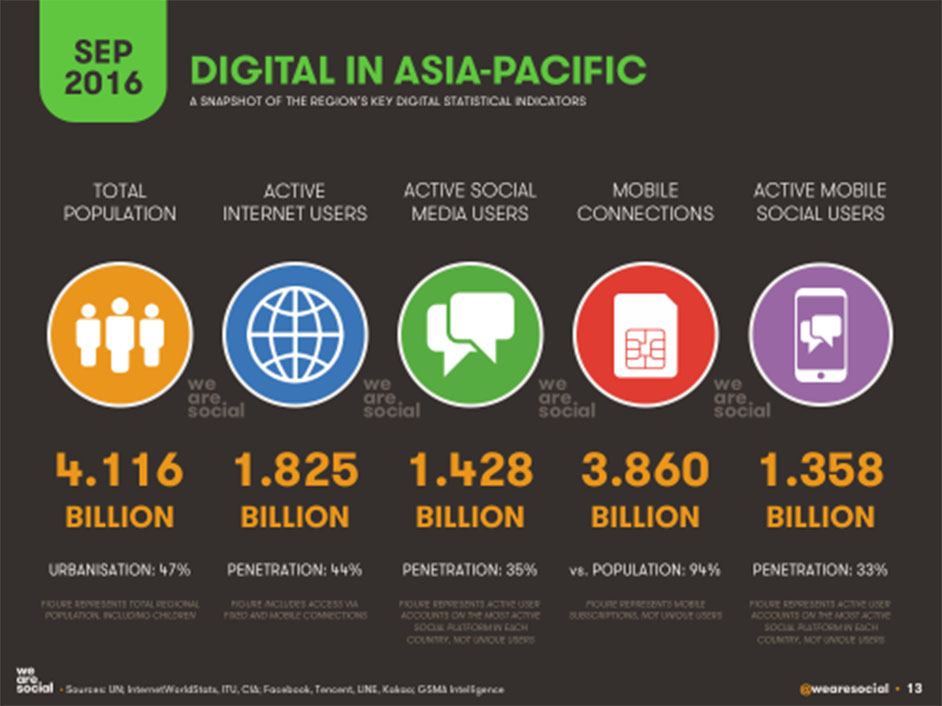Businesses need to ensure they have a clear understanding of their aims and objectives, their customers, the data they are collecting and the interactions customers have with their business. With all these elements in place, brands that operate in Singapore – the gateway to Asia – can begin to build truly effective data driven campaigns.
Singapore has quickly established itself as a prime location for businesses to conduct their marketing activities. Its strategic location in the Asia Pacific (APAC) region has enabled it to act as a hub and gateway to the rest of Asia, making it easy for businesses and professionals alike to conduct their activities – from engaging with new clientele to marketing to a larger audience.

We Are Social’s latest report into all things digital, social and mobile in Asia-Pacific shows there has been remarkable growth in the use of connected media and devices over the past 18 months. More information is here.
As a result, many large enterprises, start-ups and SMEs have opened new offices in Singapore to take advantage of these opportunities, market to a wider audience and grow their brands.
While Singapore is in an advantageous location for businesses, it’s also important to appreciate its growing high level digital infrastructure and high level of online technology adoption. As of 2017, Singapore has the fourth highest internet penetration in Asia (behind Japan, South Korea and Taiwan), along with the fourth highest smartphone adoption globally. In addition, as of 2016, the APAC region is home to more than half of the world’s internet users – and mobile adoption has grown almost exponentially.
Yet, despite this dominance of online and mobile technology, providing marketers with tremendous amounts of data, brands in Singapore are still struggling to reach and understand their customers due to a lack of knowledge around digital technologies and their capabilities, which in turn, is preventing brands from hitting business growth targets.
In today’s digitally and technologically advanced world, marketers have access to sophisticated analytics software and tools which enable them to practically measure any marketing metric, thoroughly assess customer data and build data driven campaigns that drive customer conversions.
The marketers of today are expected to be data scientists – capable of delivering real-time, actionable information based on the data available – and, as a result, are under tremendous pressure to deliver data driven marketing insights that actually pay off.
Aim a SMART goal at the gateway to Asia
It therefore falls to the marketer to sift through that data and extract the nuggets of information that will help the business.
With all of this in mind, here are some top tips to ensure you can utilise your data to drive marketing activity.
- Set your objectives and key metrics
Before beginning any form of marketing, it is vital that the business’s objectives are identified and formulated into a SMART goal, one that is:
- Specific
- Measurable
- Attainable
- Relevant
- Timely
Once a SMART goal has been formulated, identify what metrics are going to be measured.
Conversion rates, campaign response rate, lifetime customer value and total revenue, for example, are all valuable metrics for a business. Of course, what matters to each individual business will vary.
Try to avoid vanity metrics such as likes, follows, shares, downloads and so on – as they are not truly reflective of marketing’s contribution to the business’s bottom line.
Most importantly: keep it simple, keep it SMART. Complex reporting regimes will only serve to confuse your marketing department, managers, CEOs and directors.
2. Understand your customer
Smartphone technology, 3G and 4G networks have enabled customers to be ‘always-on’ and connected to the internet. Today’s customer interacts with brands and businesses across a number of channels, investigating products and services on their phone, reading reviews at home on their desktop computer, and finally heading to the store or business to make a purchase.
With this in mind, it’s essential that brands and businesses alike develop a strategy that includes current and historic interaction data from all of their marketing channels, as this will allow them to understand how and where customers are interacting with them.
As you continue to conduct your marketing activities, you combine the data you have acquired with your buyer personas, who are highly accurate representations of your ideal customers, refining them to the point where you can comfortably predict the activity on each channel, understand buyer behaviours, and determine the conversion ratios at every point of your sales funnel.
3. Leverage cross-channel analytics
For marketers and analysts, one of the most important aspects of any of our activities is the ability to accurately track how they contribute to the bottom line. In the past, being able to clearly identify the source or channel through which a business enquiry was generated was particularly difficult – making it difficult, by extension, to prove the ROI of any marketing activity.
Cross-channel analytics provides marketers with exactly that. By utilising all of your marketing data, cross-channel analytics enables marketers to clearly visualise the path a customer takes through your website to conversion. By analysing customer behaviour and interaction, marketers can identify what channels drive conversions, popular conversion paths both in and across channels, and a detailed evaluation of specific paths.
With cross-channel analytics, you can perform:
- Funnel analysis: With cross-channel reporting, you can determine which channels, or combination of channels, provide your business with the highest returns. Cross-channel reporting can also provide you with a great deal of visibility into what paths lead to conversion. This is vital since, in today’s world, your website visitor is likely to click on multiple links, pages and content before they convert. With this level of insight and the data you have accumulated, you can develop data driven insights, allowing you to redirect your marketing spend to target the channels which are most effective at driving conversions and sales.
- Channel relationship analysis: Because of the comparative nature of cross-channel reporting, you can quickly develop a better understanding of the relationship between each of your marketing channels. Many questions can be answered with hard data, such as: What content do people engage with and when? What process do people go through before converting? What messages deliver the best engagement rates? Answering these questions, as well as obtaining the data, will enable you to build more effective marketing campaigns which continuously attract prospects.
- Predictive modelling: As your data pool grows and your analytical cross-channel reporting improves, you will gradually be able to construct predictive, data-driven models which a) highlight the impact of your marketing on the revenue generated/spent and b) allow you to alter your marketing mix on the fly to capture prospects earlier in the buyer’s journey.
4. Invest in the right platforms
In order to clearly measure performance, understand customers and develop strategies orientated around them, businesses need to invest in the right tools to support their activities. There are more than enough free and affordable tools out there, most of which are relatively simple to use. Google Analytics, for example, provides a comprehensive web analytics solution and, when combined with marketing automation platforms such as HubSpot, can provide a granular view of a business’s marketing activity and the most effective attribution paths, enabling better data driven marketing.
In addition, marketing automation platforms can take the heavy lifting out of data collection, analysis and reporting, enabling marketers to focus on developing insights based on the data collected, rather than collect that data themselves.
To succeed with data driven marketing, businesses need to ensure they have a clear understanding of their aims and objectives, their customers, the data they are collecting and the interactions customers have with their business.
With all these elements in place, brands that operate in Singapore can begin to build truly effective data-driven campaigns that deliver marketing ROI and help them to understand today’s online and tech-savvy customer.
Read also:
Finding a local voice – marketing to Chinese consumers
How to rank your website around the world: international SEO







Leave your thoughts